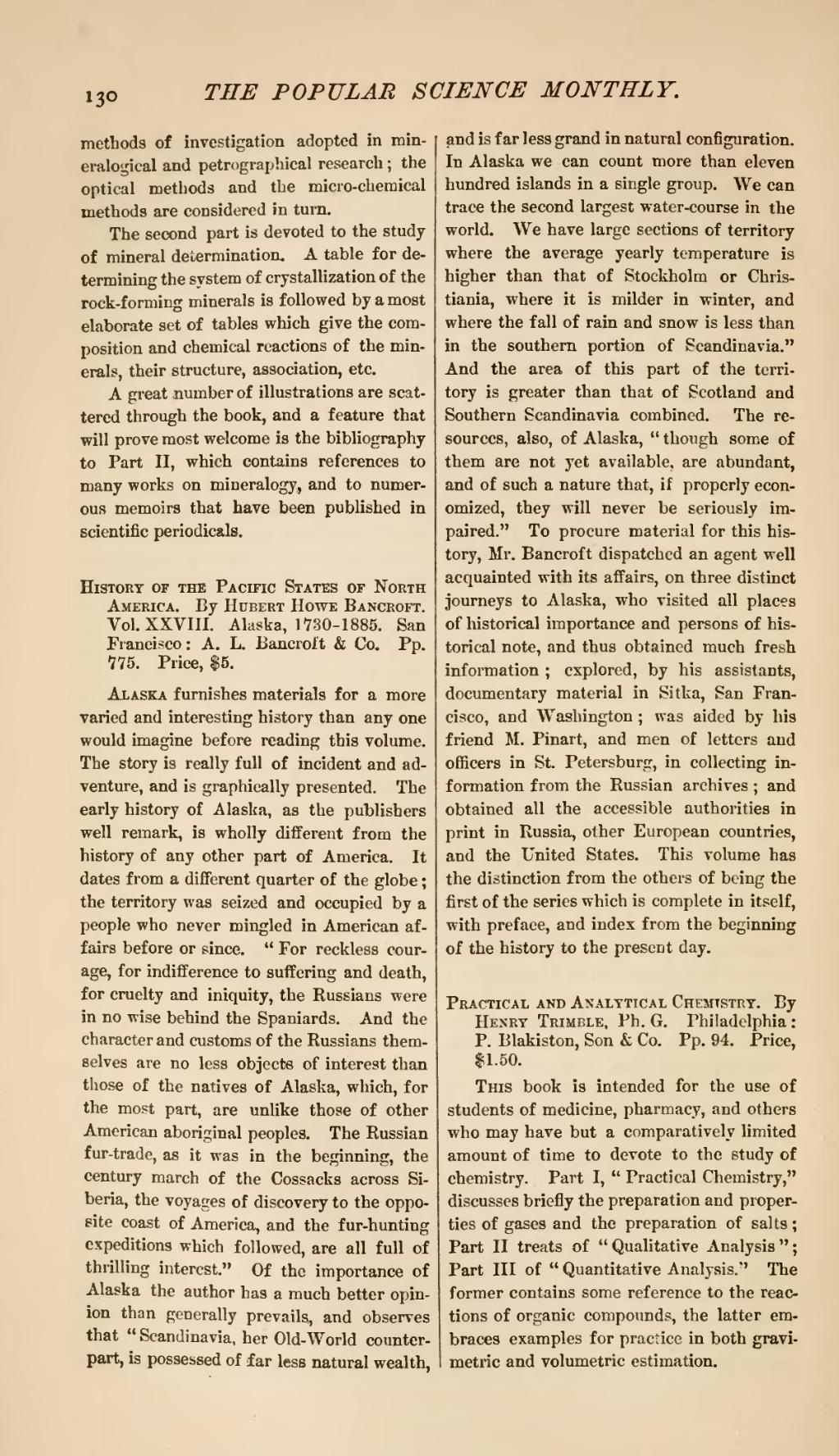methods of investigation adopted in mineralogical and petrographical research; the optical methods and the micro-chemical methods are considered in turn.
The second part is devoted to the study of mineral determination. A table for determining the system of crystallization of the rock-forming minerals is followed by a most elaborate set of tables which give the composition and chemical reactions of the minerals, their structure, association, etc.
A great number of illustrations are scattered through the book, and a feature that will prove most welcome is the bibliography to Part II, which contains references to many works on mineralogy, and to numerous memoirs that have been published in scientific periodicals.
History of the Pacific States of North America. By Hubert Howe Bancroft. Vol. XXVIII. Alaska, 1730-1885. San Francisco: A. L. Bancroft & Co. Pp. 775. Price, $5.
Alaska furnishes materials for a more varied and interesting history than any one would imagine before reading this volume. The story is really full of incident and adventure, and is graphically presented. The early history of Alaska, as the publishers well remark, is wholly different from the history of any other part of America. It dates from a different quarter of the globe; the territory was seized and occupied by a people who never mingled in American affairs before or since. "For reckless courage, for indifference to suffering and death, for cruelty and iniquity, the Russians were in no wise behind the Spaniards. And the character and customs of the Russians themselves are no less objects of interest than those of the natives of Alaska, which, for the most part, are unlike those of other American aboriginal peoples. The Russian fur-trade, as it was in the beginning, the century march of the Cossacks across Siberia, the voyages of discovery to the opposite coast of America, and the fur-hunting expeditions which followed, are all full of thrilling interest." Of the importance of Alaska the author has a much better opinion than generally prevails, and observes that "Scandinavia, her Old-World counterpart, is possessed of far less natural wealth, and is far less grand in natural configuration. In Alaska we can count more than eleven hundred islands in a single group. We can trace the second largest water-course in the world. We have large sections of territory where the average yearly temperature is higher than that of Stockholm or Christiania, where it is milder in winter, and where the fall of rain and snow is less than in the southern portion of Scandinavia." And the area of this part of the territory is greater than that of Scotland and Southern Scandinavia combined. The resources, also, of Alaska, "though some of them are not yet available, are abundant, and of such a nature that, if properly economized, they will never be seriously impaired." To procure material for this history, Mr. Bancroft dispatched an agent well acquainted with its affairs, on three distinct journeys to Alaska, who visited all places of historical importance and persons of historical note, and thus obtained much fresh information; explored, by his assistants, documentary material in Sitka, San Francisco, and Washington; was aided by his friend M. Pinart, and men of letters and officers in St. Petersburg, in collecting information from the Russian archives; and obtained all the accessible authorities in print in Russia, other European countries, and the United States. This volume has the distinction from the others of being the first of the series which is complete in itself, with preface, and index from the beginning of the history to the present day.
Practical and Analytical Chemistry. By Henry Trimble, Ph. G. Philadelphia: P. Blakiston, Son & Co. Pp. 94. Price, $1.50.
This book is intended for the use of students of medicine, pharmacy, and others who may have but a comparatively limited amount of time to devote to the study of chemistry. Part I, "Practical Chemistry," discusses briefly the preparation and properties of gases and the preparation of salts; Part II treats of "Qualitative Analysis"; Part III of "Quantitative Analysis." The former contains some reference to the reactions of organic compounds, the latter embraces examples for practice in both gravimetric and volumetric estimation.
